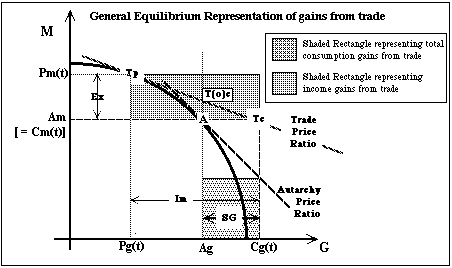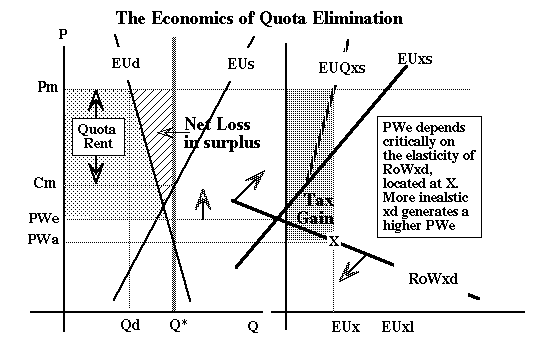AEF362: CLASS NOTES 1
Key points
From Paper 1: Food Mountains and Famines (the
World
View)
- The world does not (at least yet) have a food problem -
production
capacity
is well able to produce enough food for all. The problems are:
- food distribution and infrastructure
- inadequate incomes for the poor, reflecting inadequate
resources (land,
labour and (especially) capital - since it is capital which largely
distinguishes
the rich from the poor)
- inappropriate POLICY: rich countries subsidising domestic
production
and protecting their domestic markets from trade; poor countries
taxing food production (or attempting to subsidise food consumption by
selling food at less than costs of production) - or, equivalently,
leaving
most of the population to fend for itself in subsistence agriculture -
the trap that no surpluses are produced, trade is not possible (even
within
a country) and there is neither incentive nor opportunity to exploit
the
economies of specialisation and trade.
- Development involves fewer people earning a full time living from
agriculture
than before. Incomes to farmers will tend to fall in farming to
encourage
people to leave. Attempts to prevent these signals (through
support
of and protection for farming) will simply result in too many people
trying
to earn a living from farming - increasing asset (especially land)
prices,
so that farm production costs are increased and farm incomes are not
substantially
improved.
- Such attempts to isolate domestic (developed country) agriculture
sectors
from the world market also rebound - world prices are depressed and
support
costs become ever greater (or production levels have to be restricted
with
production quotas, set-asides and so forth)
- The Key Problem: How to resolve the logic of the market
system
(the
best way we have yet found to match productive potential with societies
demands) with the necessary co-condition that society sanctions the
justice
and equity of the market solution - which rewards the rich and
penalises
the poor, and depends on the rather capricious accidents of birth,
opportunity,
entrepreneurial risk and good timing. This problem is even more
fundamental
and critical than the more obvious criticism of the competitive market
- that it does not take adequate account of public goods or
externalities
- those things and actions which are not properly accounted for in
market
transactions, being neither contracted for not paid for in the market
system.
From Paper 2: Northern Region Agriculture and
Rural
Development: What Futures? ( The Local View)
- Farm support has done nothing to improve farm incomes, all it
does is
raise
the costs of production - both history and logic demonstrate the point.
- Poorer resources will still lead to poorer incomes, other things
being
equal - improved incomes requires more and/or better resources, or
better
management to produce more of what is wanted for less.
- But the history of support has created substantial vested
interests in
its continuance - in the form of increased farm asset prices (pension
funds
and capital resources for the industry and its dependents) - simple
elimination
is neither politically acceptable nor (perhaps more arguably)
economically
sensible.
- Rhetoric of CAP reform (under Agenda 2000 - shortened now to A2K
and subsequent reforms)
implies
reform to:
- Healthy Agricultural Trade (DRH's acronym for: no more
coupled
support,
limited and finite compensation for asset value depreciation,)
- Re-Creational agriculture - to provide CARE goods and services
-
implying
proper signals of society's willingnesses to pay for CARE etc. and
appropriate
mechanisms for ensuring delivery of these things from those best able
to
produce and supply them.
- But systems and mechanisms of support and assistance do not match
the
rhetoric.
Present systems re-inforce the status quo, and generate increasing
uncertainty
about the future, while current generation of farmers (the supposed
beneficiaries)
are increasingly recognising that the present system is of little help
to them -> potential for internal (domestic) fracture of the
political
concensus on which present policy is based. In particular - current
policies do not make any serious attempt to separate the issuse of
compensation from the requirements to pay for non-market services of
agriculture (landscape, wildlife, environment etc.)
- So what might we (society) do instead?
- HAT: Limited, fully decoupled and finite compensation
(lump sum,
or as near as politically possible) + security (safety net) to market
prices
- CARE and ReCreational Management Payments:
- If we want people to stay, live and work in rural areas when
otherwise
they would not, it has to be made attractive for them to do so - with
captial
and income and even sales tax benefits.
- CARE provision requires that we ( as members of society) are
willing to
pay for these benefits, and that our willingness to pay is
appropriately
signaled to the suppliers. We need efficient and effective ways of
ensuring
this - use the existing charitable, NGO and non-profit organisations
(CARTS,
in short) to do this, with supplementary 'top-loading', free from any
additional
constriants or accontabilities, from the treasuries.
- What of the future for the Northern Uplands?
- World Competitive agricultural production? = ranching and
low
cost
production on a large scale? Often impossible, depending on
location,
because the land is too valuable for other (CARE) reasons
- CARE (recreational agriculture) alone? Recreational
demands are
certainly
growing, but probably insufficient willingness to pay to preserve
present
strcutures and activities (though yet to be tested in genuine market
place)
except in particular circumstances.
- Originality? - exploit growing demands for difference and
differentiation
- 'eat the view', locality and originality - use the market as a living
ecology, developing niches and habitats which are self-sustaining and
self-promoting.
The key distinction between genuine competitiveness and the
conventional
economic concept of (perfect) competion.
- None of these, however, are sensibly encouraged or assisted by
bureacratic
attempts to regulate, proscribe or define what the market wants or is
willing
to pay for.
- Conclusion - it is not the market which fails - it is our notions
of
democracy
(all power to the majority voter, regardless of who pays) and
government.
Yet we have no established and accepted analytical framework or
'science'
on which to base sensible discussion of political failures and
democratic
deficits - other than assinine assertions of some nebulous 'third way'.
Questions & Discussion:
- What, exactly, does distortion mean?
- Provisional answer - interference with market determined prices
(other
than to correct for public goods and externalities), since there is no
such thing as a unique set of prices which can simultaneously satisfy
social
wishes for justice (relating to endowments of resources (land, labour,
capital and management skills)) while also satisfying market balance
(equilibrium)
and efficient allocation (corrected for public goods and externalities).
Simple Story of why Trade (and associated specialisation) is a
"Good
Thing"
 Any
society (household, region, nation etc.) can be represented as having a
particular productive capacity, given its resources of land, labour,
capital
and management) such that its production possibilities are shown as the
Production Possibility Frontier - concave to the origin, since some
resources
are better at producing one thing (say M) than another (say G).
Any
society (household, region, nation etc.) can be represented as having a
particular productive capacity, given its resources of land, labour,
capital
and management) such that its production possibilities are shown as the
Production Possibility Frontier - concave to the origin, since some
resources
are better at producing one thing (say M) than another (say G).
Without trade (under conditions of autarchy), this society will
choose
some particular mix of M and G (say at point A, producing and,
necessarily,
consuming amounts Am and Ag respectively). Notice that this
choice,
whatever it is, necessarily requires that the rate at which these two
goods
can be exchanged (both on the supply (ppf) side and the demand side of
the local domestic market) will be equal to the Autarchy Price
Ratio.
Supply price (the slope of the ppf) is equal to the demand price (given
by the choice exercised by the society as to which mix of goods to
consume).
The market is in balance, and, providing that the ppf and the choices
exercised
by society include all public goods and externalities), the efficient
price.
Supply curves - the price at which succesive amounts of any one good
can
be produced - necessarily slope upwards for this reason.
(Question
- do demand curves necessarily slope downwards, and does it
matter
if they don't?).
Trade will only occur if this society meets and negotiates with some
different society (with different ppf, and/or different social
valuations
on the possible products). If all societies are exactly the same,
then trade will neither happen nor be sensible. Trade relies on
differences
- so the "level playing field" notion is very misleading.
When trade happens, a new and different price ratio will be
established
- the Trade Price Ratio. This society can now choose a new
combination
of goods to consume, not totally restricted by its own ppf - it can
specialise
in the production of the good which is more valuable in trade (good M
in
this case), and export some of this good (amount Pm(t) less Am) in
return
for imports of G (amount Cg(t) less Pg(t)). Amount Ex of M buys
amount
Im of G on the 'world' market. So now our society is consuming at
point Tc (chosen arbitrarily here to be the same amount of M as before,
but more G - unambigously better off. By how much?
By the value of the additional G consumed, valued at the pre-trade
price
ratio given by the autarchic price ratio. Or, by the increased
income
generated by trade - the value of the exports valued at the trade price
ratio. The two values are not identical - they are measured at
different
price relatives (real prices). Which is the most relevant depends
on the reasons we need the measurement - but the difference does not
invalidate
the general principle - people are better off if they specialise and
trade.
Otherwise, we wouldn't do it. And we do, all the time. Very
very few of us, if any, really choose to be totally self-sufficient -
life
is too short and too miserable if we do.
Restriction of trade or distortion of trading price ratios
necessarily
makes our society worse off than it otherwise could be. Q.E.D.
An Illustration: The gains to be made from elimination of
EU
Dairy Quotas and associated price support
 Intervention
buying, export refunds and import levies on dairy products (Skim Milk
Powder
(SMP) and Butter) support domestic EU prices at Pm, with production
restricted
by quota at Q*. Elimination of quota alone, without also
eliminating
supported prices, makes no sense (make sure you understand why not).
Intervention
buying, export refunds and import levies on dairy products (Skim Milk
Powder
(SMP) and Butter) support domestic EU prices at Pm, with production
restricted
by quota at Q*. Elimination of quota alone, without also
eliminating
supported prices, makes no sense (make sure you understand why not).
However, if both are eliminated, producers lose less than consumers
and taxpayers gain. The combined producers loss and consumers
gain
results in a net loss in surplus shown in the diagram, which is
necessarily
less than the taxpayers gain.
See the summary of the recent study of
the
consequences of quota elimination for the current estimates of the
gains
versus the losses (from the DEFRA
web site containing the whole report) in preparation for next weeks
class - and come prepared to answer the question as to why quotas were
introduced in the first place, if they are now such a "bad" thing!
Back to AEF362 Index.
Intervention
buying, export refunds and import levies on dairy products (Skim Milk
Powder
(SMP) and Butter) support domestic EU prices at Pm, with production
restricted
by quota at Q*. Elimination of quota alone, without also
eliminating
supported prices, makes no sense (make sure you understand why not).